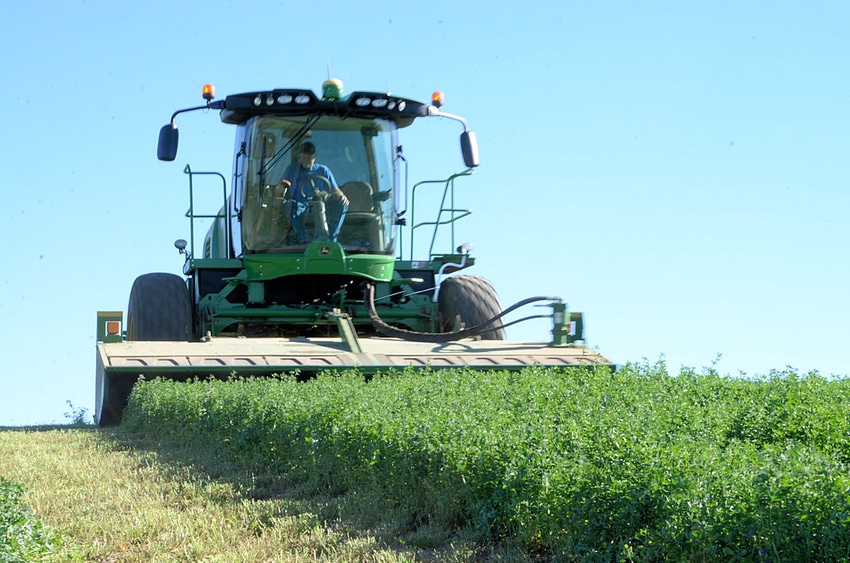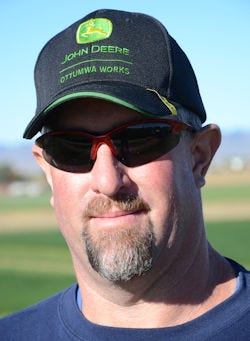February 3, 2016

It’s pretty easy to get the idea that autosteering is everywhere and everyone is using it. For several years, Steve Beitz has been using some form of the technology in his machinery at his Wellington, Colo., operation, but always as an add-on.
“We used autoguidance with our pull-type swathers in the tractors, and it made a difference,” he says. “But now we have a higher level of precision.”
For 2015, Beitz upgraded to a W235 John Deere self-propelled windrower, which features integrated AutoTrac autoguidance. Sounds simple, but with AutoTrac, Beitz and his employees can cut faster and more precisely to keep up in a time-sensitive business.
“Green is gold,” Beitz says. “We have to cut when the crop is ready. But the biggest benefit we see is that there’s less fatigue after running a long day.”

Steve Beitz has found that integrated autosteering in a self-propelled windrower has a key payback in reducing fatigue and improving finished hay quality.
Steve Beitz has found that integrated autosteering in a self-propelled windrower has a key payback in reducing fatigue and improving finished hay quality.Keenan Gaab, 4 Rivers Equipment, Fort Collins, Colo., has worked with Beitz for several years and explains that his customers who turn to tools like autosteering are seeing the same results he has seen. “Precision agriculture tools, including autosteering and more advanced tools like My John Deere Operations Center, are becoming more popular in this area,” he notes. “There’s a payoff with this technology.”
Quality matters
Beyond being less fatigued, Beitz points to a benefit of precision autoguidance in using a windrower that may not have occurred to some operators. “In the past, we’d see the windrow vary in width from 12 to 16 feet of material in a single pass. When the baler goes through that, you get a ‘slug’ of material, a kind of lumping effect.”
The inconsistent windrow also has a variable drydown, which can impact final hay quality. A more consistent windrow width means Beitz is producing higher-quality hay for his customers.
Beitz’s business cuts more than 4,000 acres of alfalfa, bromegrass-
orchardgrass and sorghum-sudangrass forages for different customers. He’s marketing high-quality hay to horse owners in southern Colorado. The business also is a supplier for a dairy heifer finishing business that requires consistent quality and delivery of hay. Beitz also farms 800 acres of his own ground.
While some talk about being able to run at higher speeds with auto-guidance, Beitz says the bigger key is being able to run at a consistent speed. “We could run consistently at 8 mph with the bolt-on autosteer system as long as it was in a straight line. In some center-pivot ground, we can run at speeds up to 14 mph in a circle with the new integrated system.”
With the new machine and its AutoTrac system, Beitz says he is seeing higher productivity. “We’re going to be able to add acres without adding more machines.”
And that can offer him a bigger paycheck for the future.
About the Author(s)
You May Also Like






